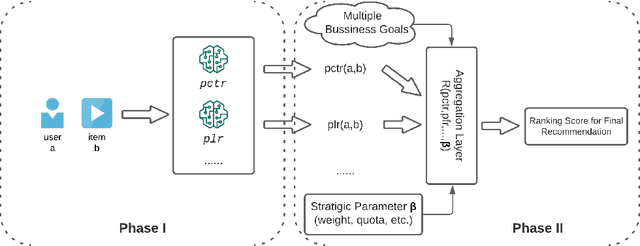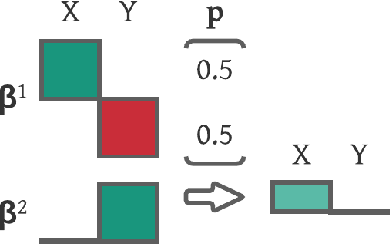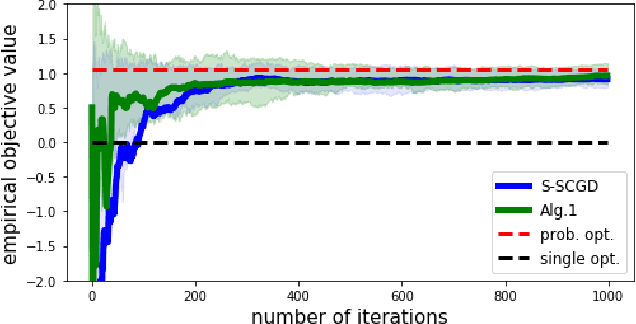Yongqi Liu
Stratified Expert Cloning with Adaptive Selection for User Retention in Large-Scale Recommender Systems
Apr 08, 2025Abstract:User retention has emerged as a critical challenge in large-scale recommender systems, significantly impacting the long-term success of online platforms. Existing methods often focus on short-term engagement metrics, failing to capture the complex dynamics of user preferences and behaviors over extended periods. While reinforcement learning (RL) approaches have shown promise in optimizing long-term rewards, they face difficulties in credit assignment, sample efficiency, and exploration when applied to the user retention problem. In this work, we propose Stratified Expert Cloning (SEC), a novel imitation learning framework that effectively leverages abundant logged data from high-retention users to learn robust recommendation policies. SEC introduces three key innovations: 1) a multi-level expert stratification strategy that captures the nuances in expert user behaviors at different retention levels; 2) an adaptive expert selection mechanism that dynamically assigns users to the most suitable policy based on their current state and historical retention level; and 3) an action entropy regularization technique that promotes recommendation diversity and mitigates the risk of policy collapse. Through extensive offline experiments and online A/B tests on two major video platforms, Kuaishou and Kuaishou Lite, with hundreds of millions of daily active users, we demonstrate SEC's significant improvements over state-of-the-art methods in user retention. The results demonstrate significant improvements in user retention, with cumulative lifts of 0.098\% and 0.122\% in active days on Kuaishou and Kuaishou Lite respectively, additionally bringing tens of thousands of daily active users to each platform.
Comment Staytime Prediction with LLM-enhanced Comment Understanding
Apr 02, 2025Abstract:In modern online streaming platforms, the comments section plays a critical role in enhancing the overall user experience. Understanding user behavior within the comments section is essential for comprehensive user interest modeling. A key factor of user engagement is staytime, which refers to the amount of time that users browse and post comments. Existing watchtime prediction methods struggle to adapt to staytime prediction, overlooking interactions with individual comments and their interrelation. In this paper, we present a micro-video recommendation dataset with video comments (named as KuaiComt) which is collected from Kuaishou platform. correspondingly, we propose a practical framework for comment staytime prediction with LLM-enhanced Comment Understanding (LCU). Our framework leverages the strong text comprehension capabilities of large language models (LLMs) to understand textual information of comments, while also incorporating fine-grained comment ranking signals as auxiliary tasks. The framework is two-staged: first, the LLM is fine-tuned using domain-specific tasks to bridge the video and the comments; second, we incorporate the LLM outputs into the prediction model and design two comment ranking auxiliary tasks to better understand user preference. Extensive offline experiments demonstrate the effectiveness of our framework, showing significant improvements on the task of comment staytime prediction. Additionally, online A/B testing further validates the practical benefits on industrial scenario. Our dataset KuaiComt (https://github.com/lyingCS/KuaiComt.github.io) and code for LCU (https://github.com/lyingCS/LCU) are fully released.
AlignPxtr: Aligning Predicted Behavior Distributions for Bias-Free Video Recommendations
Mar 11, 2025Abstract:In video recommendation systems, user behaviors such as watch time, likes, and follows are commonly used to infer user interest. However, these behaviors are influenced by various biases, including duration bias, demographic biases, and content category biases, which obscure true user preferences. In this paper, we hypothesize that biases and user interest are independent of each other. Based on this assumption, we propose a novel method that aligns predicted behavior distributions across different bias conditions using quantile mapping, theoretically guaranteeing zero mutual information between bias variables and the true user interest. By explicitly modeling the conditional distributions of user behaviors under different biases and mapping these behaviors to quantiles, we effectively decouple user interest from the confounding effects of various biases. Our approach uniquely handles both continuous signals (e.g., watch time) and discrete signals (e.g., likes, comments), while simultaneously addressing multiple bias dimensions. Additionally, we introduce a computationally efficient mean alignment alternative technique for practical real-time inference in large-scale systems. We validate our method through online A/B testing on two major video platforms: Kuaishou Lite and Kuaishou. The results demonstrate significant improvements in user engagement and retention, with \textbf{cumulative lifts of 0.267\% and 0.115\% in active days, and 1.102\% and 0.131\% in average app usage time}, respectively. The results demonstrate that our approach consistently achieves significant improvements in long-term user retention and substantial gains in average app usage time across different platforms. Our core code will be publised at https://github.com/justopit/CQE.
Conditional Quantile Estimation for Uncertain Watch Time in Short-Video Recommendation
Jul 17, 2024Abstract:Within the domain of short video recommendation, predicting users' watch time is a critical but challenging task. Prevailing deterministic solutions obtain accurate debiased statistical models, yet they neglect the intrinsic uncertainty inherent in user environments. In our observation, we found that this uncertainty could potentially limit these methods' accuracy in watch-time prediction on our online platform, despite that we have employed numerous features and complex network architectures. Consequently, we believe that a better solution is to model the conditional distribution of this uncertain watch time. In this paper, we introduce a novel estimation technique -- Conditional Quantile Estimation (CQE), which utilizes quantile regression to capture the nuanced distribution of watch time. The learned distribution accounts for the stochastic nature of users, thereby it provides a more accurate and robust estimation. In addition, we also design several strategies to enhance the quantile prediction including conditional expectation, conservative estimation, and dynamic quantile combination. We verify the effectiveness of our method through extensive offline evaluations using public datasets as well as deployment in a real-world video application with over 300 million daily active users.
PASTO: Strategic Parameter Optimization in Recommendation Systems -- Probabilistic is Better than Deterministic
Aug 20, 2021



Abstract:Real-world recommendation systems often consist of two phases. In the first phase, multiple predictive models produce the probability of different immediate user actions. In the second phase, these predictions are aggregated according to a set of 'strategic parameters' to meet a diverse set of business goals, such as longer user engagement, higher revenue potential, or more community/network interactions. In addition to building accurate predictive models, it is also crucial to optimize this set of 'strategic parameters' so that primary goals are optimized while secondary guardrails are not hurt. In this setting with multiple and constrained goals, this paper discovers that a probabilistic strategic parameter regime can achieve better value compared to the standard regime of finding a single deterministic parameter. The new probabilistic regime is to learn the best distribution over strategic parameter choices and sample one strategic parameter from the distribution when each user visits the platform. To pursue the optimal probabilistic solution, we formulate the problem into a stochastic compositional optimization problem, in which the unbiased stochastic gradient is unavailable. Our approach is applied in a popular social network platform with hundreds of millions of daily users and achieves +0.22% lift of user engagement in a recommendation task and +1.7% lift in revenue in an advertising optimization scenario comparing to using the best deterministic parameter strategy.
 Add to Chrome
Add to Chrome Add to Firefox
Add to Firefox Add to Edge
Add to Edge